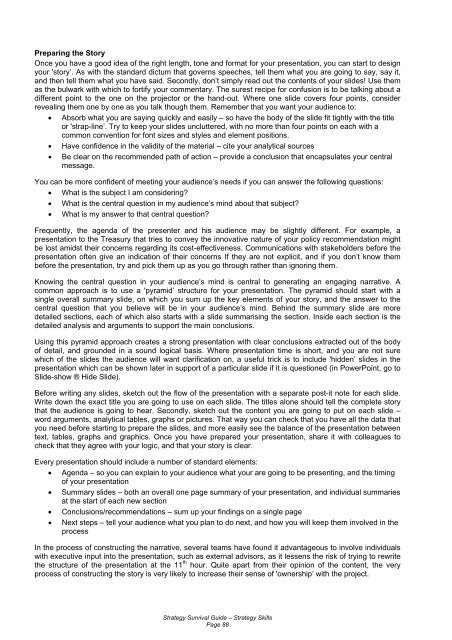Strategy Survival Guide
Strategy Survival Guide
Strategy Survival Guide
Create successful ePaper yourself
Turn your PDF publications into a flip-book with our unique Google optimized e-Paper software.
Preparing the Story<br />
Once you have a good idea of the right length, tone and format for your presentation, you can start to design<br />
your 'story’. As with the standard dictum that governs speeches, tell them what you are going to say, say it,<br />
and then tell them what you have said. Secondly, don’t simply read out the contents of your slides! Use them<br />
as the bulwark with which to fortify your commentary. The surest recipe for confusion is to be talking about a<br />
different point to the one on the projector or the hand-out. Where one slide covers four points, consider<br />
revealing them one by one as you talk though them. Remember that you want your audience to:<br />
• Absorb what you are saying quickly and easily – so have the body of the slide fit tightly with the title<br />
or 'strap-line’. Try to keep your slides uncluttered, with no more than four points on each with a<br />
common convention for font sizes and styles and element positions.<br />
• Have confidence in the validity of the material – cite your analytical sources<br />
• Be clear on the recommended path of action – provide a conclusion that encapsulates your central<br />
message.<br />
You can be more confident of meeting your audience’s needs if you can answer the following questions:<br />
• What is the subject I am considering?<br />
• What is the central question in my audience’s mind about that subject?<br />
• What is my answer to that central question?<br />
Frequently, the agenda of the presenter and his audience may be slightly different. For example, a<br />
presentation to the Treasury that tries to convey the innovative nature of your policy recommendation might<br />
be lost amidst their concerns regarding its cost-effectiveness. Communications with stakeholders before the<br />
presentation often give an indication of their concerns If they are not explicit, and if you don’t know them<br />
before the presentation, try and pick them up as you go through rather than ignoring them.<br />
Knowing the central question in your audience’s mind is central to generating an engaging narrative. A<br />
common approach is to use a 'pyramid’ structure for your presentation. The pyramid should start with a<br />
single overall summary slide, on which you sum up the key elements of your story, and the answer to the<br />
central question that you believe will be in your audience’s mind. Behind the summary slide are more<br />
detailed sections, each of which also starts with a slide summarising the section. Inside each section is the<br />
detailed analysis and arguments to support the main conclusions.<br />
Using this pyramid approach creates a strong presentation with clear conclusions extracted out of the body<br />
of detail, and grounded in a sound logical basis. Where presentation time is short, and you are not sure<br />
which of the slides the audience will want clarification on, a useful trick is to include 'hidden’ slides in the<br />
presentation which can be shown later in support of a particular slide if it is questioned (in PowerPoint, go to<br />
Slide-show ® Hide Slide).<br />
Before writing any slides, sketch out the flow of the presentation with a separate post-it note for each slide.<br />
Write down the exact title you are going to use on each slide. The titles alone should tell the complete story<br />
that the audience is going to hear. Secondly, sketch out the content you are going to put on each slide –<br />
word arguments, analytical tables, graphs or pictures. That way you can check that you have all the data that<br />
you need before starting to prepare the slides, and more easily see the balance of the presentation between<br />
text, tables, graphs and graphics. Once you have prepared your presentation, share it with colleagues to<br />
check that they agree with your logic, and that your story is clear.<br />
Every presentation should include a number of standard elements:<br />
• Agenda – so you can explain to your audience what your are going to be presenting, and the timing<br />
of your presentation<br />
• Summary slides – both an overall one page summary of your presentation, and individual summaries<br />
at the start of each new section<br />
• Conclusions/recommendations – sum up your findings on a single page<br />
• Next steps – tell your audience what you plan to do next, and how you will keep them involved in the<br />
process<br />
In the process of constructing the narrative, several teams have found it advantageous to involve individuals<br />
with executive input into the presentation, such as external advisors, as it lessens the risk of trying to rewrite<br />
the structure of the presentation at the 11 th hour. Quite apart from their opinion of the content, the very<br />
process of constructing the story is very likely to increase their sense of 'ownership’ with the project.<br />
<strong>Strategy</strong> <strong>Survival</strong> <strong>Guide</strong> – <strong>Strategy</strong> Skills<br />
Page 88
















